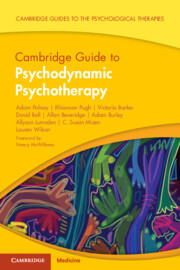Book contents
- Cambridge Guide to Psychodynamic Psychotherapy
- Cambridge Guides to the Psychological Therapies
- Reviews
- Cambridge Guide to Psychodynamic Psychotherapy
- Copyright page
- Dedication
- Contents
- Foreword
- Preface
- A Note from the Series Editor
- Acknowledgements
- Part 1: An Overview of the Model
- Part 2: The Model of Psychodynamic Psychotherapy into Practice
- Chapter 5 Framing a Psychodynamic Space
- Chapter 6 The Goals of Psychodynamic Psychotherapy
- Chapter 7 Psychodynamic Psychotherapy Technique
- Chapter 8 The Overall Structure of Psychodynamic Therapy
- Chapter 9 Psychological Assessment and Formulation in Psychodynamic Psychotherapy
- Chapter 10 Some Reflections on the Supervisory Process
- Part 3: Application for Mental Health Presentations
- Part 4: Application of Psychodynamic Psychotherapy in Different Populations and in Different Settings
- Glossary of Terms
- Index
- References
Chapter 9 - Psychological Assessment and Formulation in Psychodynamic Psychotherapy
from Part 2: - The Model of Psychodynamic Psychotherapy into Practice
Published online by Cambridge University Press: 25 August 2023
- Cambridge Guide to Psychodynamic Psychotherapy
- Cambridge Guides to the Psychological Therapies
- Reviews
- Cambridge Guide to Psychodynamic Psychotherapy
- Copyright page
- Dedication
- Contents
- Foreword
- Preface
- A Note from the Series Editor
- Acknowledgements
- Part 1: An Overview of the Model
- Part 2: The Model of Psychodynamic Psychotherapy into Practice
- Chapter 5 Framing a Psychodynamic Space
- Chapter 6 The Goals of Psychodynamic Psychotherapy
- Chapter 7 Psychodynamic Psychotherapy Technique
- Chapter 8 The Overall Structure of Psychodynamic Therapy
- Chapter 9 Psychological Assessment and Formulation in Psychodynamic Psychotherapy
- Chapter 10 Some Reflections on the Supervisory Process
- Part 3: Application for Mental Health Presentations
- Part 4: Application of Psychodynamic Psychotherapy in Different Populations and in Different Settings
- Glossary of Terms
- Index
- References
Summary
The consultation is likely to be the first experience the patient has of a psychodynamic way of thinking and it has the potential to be an experience of being deeply heard and understood. In the consultation period the aim is for the therapist to have an experience of the internal world of the patient and the patient an experience of what the therapy will be like. A consultation over a series of meetings may even give the opportunity of developing a patient’s capacity to undertake therapeutic work. It is a complex process that often starts before the patient even enters the room. There are different approaches to the consultation process and some of these are discussed. Given that the psychodynamic consultation is an encounter which will, in all likelihood, create anxiety and a sense of vulnerability in the patient, we can expect to see defences emerging in the moment-by-moment interaction and these are considered. A tripartite structure of psychodynamic formulation is outlined as a helpful framework for picking out the relational dynamic
Keywords
- Type
- Chapter
- Information
- Cambridge Guide to Psychodynamic Psychotherapy , pp. 151 - 161Publisher: Cambridge University PressPrint publication year: 2023



